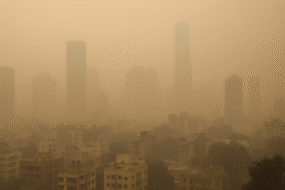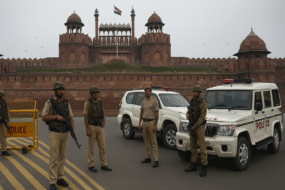The national capital woke up to another smog-filled morning on Saturday as Delhi’s average Air Quality Index (AQI) reached 335 at 9 am, according to data from the Central Pollution Control Board (CPCB). The alarming figure placed the city firmly in the ‘red zone’, categorised as ‘very poor’, making Delhi the most polluted city in India for the day.
The thick layer of smog blanketed the skyline, cutting visibility and forcing residents to grapple with eye irritation and breathing difficulties. The pollution levels were dominated by fine PM2.5 particles, known to penetrate deep into the lungs and bloodstream.
🌫️ Pollution Persists Since Diwali
Delhi’s air quality has steadily worsened since Diwali, fluctuating between the ‘poor’ and ‘severe’ categories. Despite a series of anti-pollution measures, including restrictions on stubble burning, construction, and vehicle movement under GRAP Stage IV, the city’s efforts have shown little immediate impact.
Visibility dropped sharply across parts of central and south Delhi, while residents in Noida, Ghaziabad, and Gurugram also reported thick smog and burning sensations in the eyes.
The city’s temperature dropped to 11°C, three notches below the seasonal average, as per the India Meteorological Department (IMD).
“The calm wind speed and low temperatures are trapping pollutants close to the ground, worsening the smog condition,” said an IMD official.
🌡️ Temperature and Weather Forecast
The IMD recorded a maximum temperature of 28.6°C, slightly below normal for this time of year. The minimum temperature of 11°C marks the gradual onset of winter — slightly delayed compared to previous years:
- 2024: 9.5°C (Oct 29)
- 2023: 9.2°C (Oct 23)
- 2022: 7.3°C (Oct 29)
Meteorologists have forecast a mainly clear sky for the coming days but warn that stagnant air and low wind speed could trap more pollutants over the capital.
😷 Residents Battle Dual Crisis
As Delhiites prepare for a colder winter, experts warn that the combination of falling temperatures and high pollution could worsen respiratory illnesses.
“We are entering a dangerous phase where air pollution and cold weather together can severely impact vulnerable groups — especially children and the elderly,” said an environmental health expert.
Hospitals have reported a surge in patients suffering from cough, wheezing, and breathlessness, while several schools are urging parents to limit children’s outdoor exposure.
With no significant change in wind patterns or rainfall expected, Delhi’s toxic air crisis is likely to persist through mid-November, experts caution.






2 replies on “Delhi Chokes as AQI Hits 335, Enters ‘Red Zone’ to Become India’s Most Polluted City”
[…] Originally published on 24×7-news.com. […]
[…] Originally published on 24×7-news.com. […]